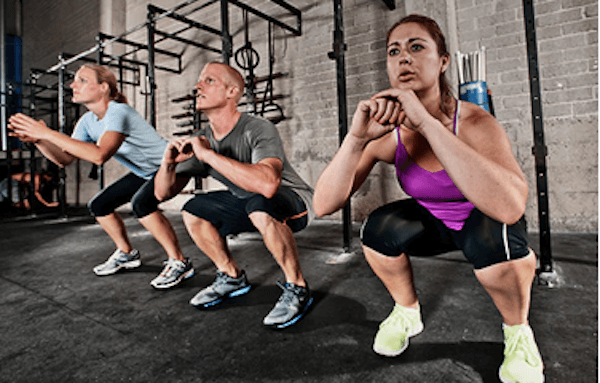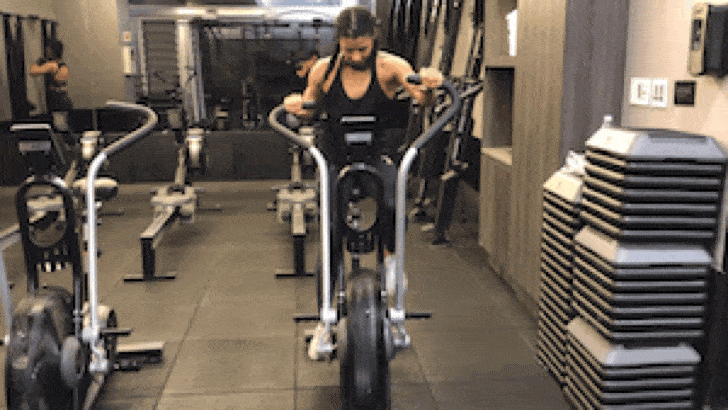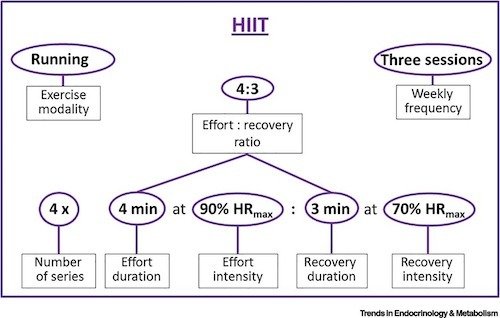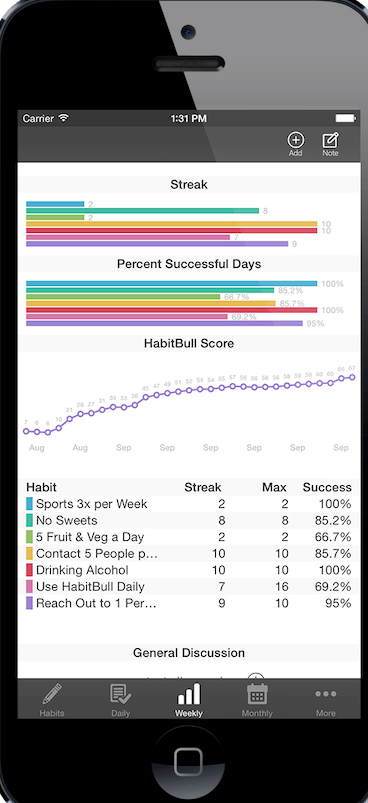A 4-Minute Exercise Snack You Can Do At Home, Part 2

A 4-minute exercise routine that can take the place of hours in the gym? Sounds improbable. And it is. Nonetheless just 4-minutes of exercise done with the right intensity can make a world of difference to your health and fitness. Check out why and how.
4-minute exercise snacks can help avert a big problem that many of us face — not moving! I do realize that there’s some movement that we regularly do, such as move from house to car; from car to building; repeat.
Unfortunately, that’s not enough if you want good health, not to mention some modicum of fitness. For either of those, you need to move. Frequently. And breathlessly.
Our bodies were meant to move frequently, and faster than a snail’s pace
Even religiously exercising three or four times a week may not be enough to relieve the ill effects of sitting all day long.
As I wrote in 6 Ways Sitting Will Kill You, Even If You Exercise, sitting can mess with you in six specific ways:
- Lower extremity problems like poor circulation leading to deep vein thrombosis and osteoporosis.
- A whole assortment of chronic diseases, such as:
- 112% increase in the risk of diabetes,
- 47% increase in “cardiovascular events” (including heart attacks), and
- 90% increase in death due to those events.
- Deteriorating mental health.
- Chronic kidney disease, particularly for women, who when reducing their sitting time from a full eight to three hours reduced the risk by 30%. (For men it’s 15%.)
- An increased risk of metabolic syndrome by 73%.
- Muscle degeneration, including nice soft saggy glutes, and weak, paunchy abs.
For all that not to happen, I wrote a two-part series about “exercise snacks. Part 1 covered a 7-minute exercise snack, and this one is about a 4-minute exercise snack, just in case you’re really, really short on time.
You can start off by doing it just once a day, and then either expand the time to the 7-minute routine, or add another 4-minute exercise session to your day. Then add another, and another, until — wow — you’re a stud!
Let’s get started…
What's in this post:
First off, you have to make three decisions:
- Are you able to perform HIIT? That’s short for High Intensity Interval Training, and it’s only for people who are accustomed to exercise, and are physiologically ready to increase exercise intensity.
- What combination of exercises to do over the 4-minute interval?
- How do you want to program the 4-minute exercise routine into your life?
Are You Ready for HIIT?
I have a cautionary tale to tell.
There I was, a 58 year-old dude sprinting up a long set of cement stairs in the hills of Sausalito, California. I was pretty impressed with myself. I had worked myself up to what I called the Bust Your Butt 8 program in my post, Boost Your Human Growth Hormone In 20 Minutes.
This “bust butt” program consists of:
- After a warm-up, do the exercise as fast/hard as you can for 30 seconds.
- Then slow way down (for instance, if you’re sprinting, walk) for 90 seconds.
- Next, leap to it again for 30 seconds.
- Repeat eight times.
This HIIT type of exercise needs to tax your entire body and leave you breathless after each round that you repeat; therefore, it can’t be bicep curls, or even push-ups (by themselves), but rather exercises such as sprints (running, biking or swimming), burpees, or the assault bike.
So, returning to my tale of woe — I did not heed my own advice; rather, I (literally) sprinted into my Bust Your Butt 8 stair sprinting program before my body was ready for that level of intensity. I should have spent weeks slowly working up to the repeated sprints by first jogging for several sessions, then gradually increasing the intensity until I could safely go all out.
But, instead, after only a few short episodes of jogging, I revved up the engine, and then it exploded. No, not a heart attack, but a seized left calf that put me out of HIIT commission for two months!
The bottom line is that full-out HIIT is for seasoned athletes, and even then you need to slowly do the exercise, and slowly increase the intensity to keep yourself from injury.
Now that you’ve (hopefully) absorbed that warning, on to a bit more about HIIT workouts through the lens of not killing yourself, but not watching videos on your phone either.
Short Workouts 101
The reason to consider doing HIIT is because short bursts of strenuous exercise can have a big, positive impact on your body. A 20-minute jog is certainly good for your heart, lungs and metabolism, but HIIT gets you there in a few minutes.
The principles of HIIT — high intensity for a few seconds up to a minute, or so, followed by a minute or more of active rest — can be applied to running, biking, stair climbing, swimming, jumping rope, rowing — and even walking.
But remember the downside: though it lasts only minutes, HIIT workouts are tough. The whole point of them is to push your body to the red line, and therein lies the danger. You must first be prepared!
How Intense Is High Intensity for the Non-athlete?
What it’s not is a casual stroll down the street, although if walking is your thing, you could stride up steep hills to get your legs and butt burning and your lungs gasping for air.
What it’s also not, unless perhaps you’re a well-conditioned athlete, is a sprint-till-your-lungs-pop explosion. Think breathless, not winded. Heart-pounding, not exploding. Legs pumping, but not so wobbly that you fall down.
Be smart and pay attention to the feedback your body is giving you. Be safe and keep the intensity at a level where during the interval you can utter single, clearly articulated words, but not complete, whole sentences. The whole sentences thing is a better measure of knowing you’re in within the aerobic threshold. In contrast, HIIT is an anaerobic exercise. The difference is jogging vs sprinting.
The bottom line is that if you choose to exercise in short, intense bursts, make sure you’re healthy and fit enough to do so, or start real slowly.
Now that the cautionary red flags have been hoisted, on two what might constitute a 4-minute exercise routine for you.
What the HIIT Research Shows
You might wonder, How in the heck can I improve my health and fitness in just 4 minutes a day?
Yeah, if you’ve ever been in a gym and seen people grunting away for hours on end, that question is top of mind. Turns out, this has been studied.
A 2019 study that looked at the effect of exercise intensity on health benefits and cardiac diseases concluded:
- Aerobic HIIT (submaximal intensity) has a low risk for people with lifestyle-related diseases, obesity, sedentary lifestyle, old age, or cardiac disorders when performed at a person’s own individual intensity.
- Classic SIT (supramaximal “sprint interval training”) is applicable only for healthy young people. However, smaller-dose and shorter SIT, such as the 2 × 20 s protocol (two rounds of 2o-second intense effort) could be utilized for sedentary young/middle-aged targets.
- The feasibility and safety of intense exercise for elderly and sedentary people, patients with stable ischemic heart disease, chronic heart failure, and patients with chronic kidney disease have not been evaluated.
Yes, you read that right: just doing two 20-second rounds of intense exercise made a difference in, pretty much, unhealthy elderly people.
But that’s not you, right? Surely, you can go for four minutes! Norway says that may be good enough.
A study published in 2013 in the journal PLoS One, researchers from the Norwegian University of Science and Technology in Trondheim, Norway attempted to find the minimum amount of exercise required to develop appreciable endurance and health gains.
They weren’t working on this in isolation. Many studies have been done over the past couple of decades have established that sessions of high-intensity exercises can be as potent, physiologically, as much longer bouts of sustained endurance exercise.
For instance, in a representative study from 2010, Canadian researchers showed that ten 1-minute intervals — ten minutes of strenuous exercise alternating with 1-minute rest periods between — had the same effect within muscle cells as 90 minutes of moderate bike riding.
In the case of the Norwegian scientists, they had for years studied the effects of intense intervals lasting for four minutes, performed at about 90% of each volunteer’s maximum heart rate, repeated four times, with a three-minute rest between each interval. The total meaningful exercise time in these sessions, then, is 16 minutes.
But what if 16 minutes is too much time for some people?
That’s what the Norwegian researchers wondered, and so they wanted to test if a single, strenuous 4-minute workout would effectively improve health and fitness.
Here’s what the researchers did to test the effectiveness of a 4-minute workout:
- 26 overweight, sedentary, but otherwise healthy middle-aged men were recruited
- Their baseline endurance and cardiovascular and metabolic health was measured, and then they were randomly assigned them to one of two groups, 13 to each.
- Half began the Norwegian researchers’ former routine: a 90 minute treadmill run at 90% of their maximal heart rate, (a pace at which you cannot talk in full sentences, but can use single words) for four 4-minute intervals, with three minutes of slow walking. The entire session was repeated three times a week for ten weeks.
- The second group, however, completed only one 4-minute strenuous run. They, too, exercised three times a week for 10 weeks.
At the end of the ten-week program, the men had increased their maximal oxygen uptake, or endurance capacity, by an average of 10% or more, with no significant differences in the gains between the two groups.
Metabolic and cardiovascular health also improved in both groups. Nearly all the men had better blood sugar control and blood pressure profiles, irrespective of whether they exercised for 16 or four minutes per session.
The bottom line is that four minutes of intense exercise is all you need, perhaps at least three times a week, should your aim be a healthy, relatively fit body. Of course, this will not make you some lean and mean machine, or make you an athlete — we’re just talking the minimum effective dose to prevent you from merging with the couch cushion.
Choose Your 4-Minute Exercise Routine
I’ve already recounted the research that shows the benefits of relatively short bursts of exercise, and now let’s consider three 4-minute exercise routines of varying intensity.
A 4-minute exercise routine is any exercise that you can do for four minutes that leaves you breathless. If you can bike, swim, row or run at near-top speed for a solid four minutes, four minutes is all you may need for overall health benefits.
What follows are three 4-minute sessions to consider that I curated from YouTube, from easy peasy to damn hard. But first, some tips:
Squats:
- Legs hip width apart or more, toes turned slightly out.
- Before you descend, stick your butt out like you’re about to sit in a chair.
- Make sure your knees stay over your toes, not bowed in or out.
- Descend as far as comfortable.
Push-ups:
- Arms shoulder width apart or slightly more.
- Elbows at 45 degrees; meaning, their neither against your body or flared out like an albatross.
- Stiffen the entire body and keep it that way.
- Do them on your knees or against a sturdy table or wall, if needed.
Easy Peasy for Beginners
This 4-minute exercise session is not HIIT, but it’s a good place to start if for you exercise is about as novel as winged flight.
If this is too easy, consider adding it after a harder 4-minute or a 7-minute workout later in the day, thereby getting more minutes of breathlessness into your day.
Harder than Easy
Tip: Don’t forget to breathe during the 10-second hold at the end of each squat.
Most Difficult of the Three
Tips, if needed:
- For high knees running in place, you may just lift your legs — of course, one at a time.
- For jumping jacks just step to the left or right instead of jumping.
- For squat jumps, forget the jump.
- For push-ups, kneel, or do them against a sturdy table or wall.
- For burpees, rather than jump back or front, step to and fro. Keep your core tight — don’t let it sag like the fella demonstrating this 4-minute exercise routine is doing.
- For mason twists, let your heels rest slightly on the floor.
Of course, your 4-minute exercise routine need not be limited to any of these three, or any others done inside. You can apply this method of 20-plus seconds of effort, 5 to 10 seconds of active rest (no sleeping) to outdoor activities, such as bike riding, running or walking. As mentioned earlier, for walking you’ll need some sort of resistance, such as a steep hill, as for most people it’s hard to get breathless walking fast in the short intervals reviewed here.
And now the question is, Are you going to do any of this?
How To Ensure You’ll Do It
In a typical day, I do several two to 4-minute exercise sessions throughout the day, because my work entails sitting, and I fear sitting all day without reprieve. (Read why sitting a lot ruins your health.)
To remind me to get off me arse and move, I use an app called HabitBull.
You can use it to reinforce any nascent habit that you want to cement into your lifestyle. I have it ping me every hour. I set it up to do that, and each notification can have a prescribed action to do, such as one of those 4-minute exercise routines.
You can download HabitBull onto your IOS or Android phone, set up what you want it to remind yourself to do, and then schedule the reminders.
That’s the easy part.
The hard part is to get off your duff when HabitBull pings you, and go do what you planned to do. In my case, I push myself away from the desk, and go do some exercise that will get me breathing hard. Sometimes it’s just for one minute — but at the end of it I’m huffing and puffing.
If something you want to make habitual has been eluding you, try HabitBull.
Last Updated on May 1, 2022 by Joe Garma








